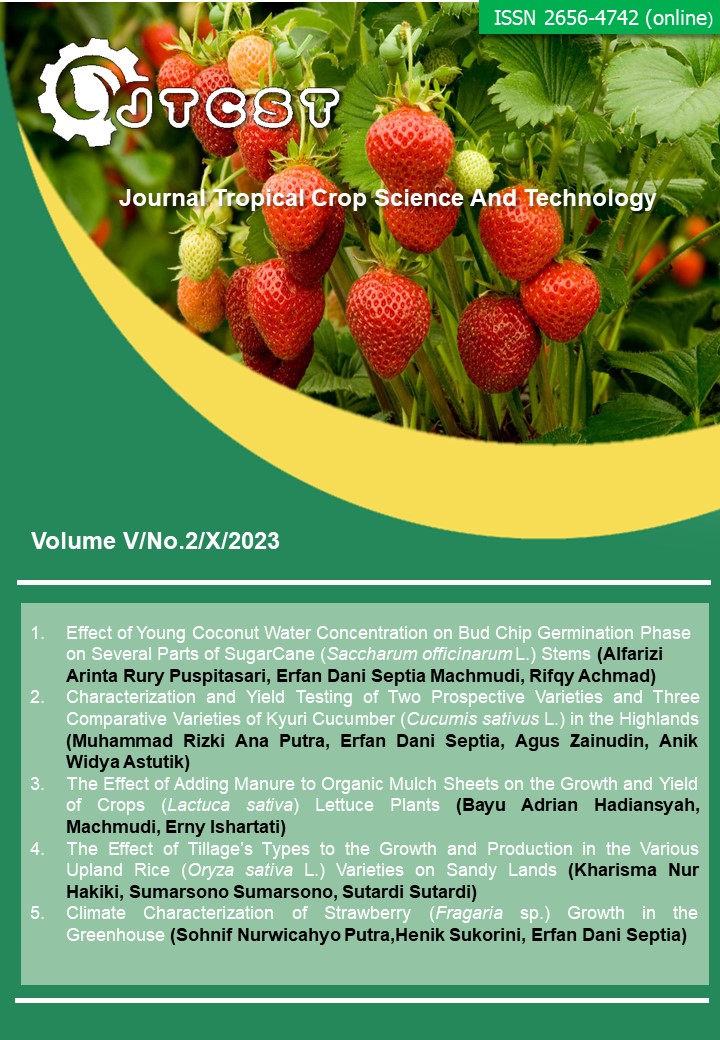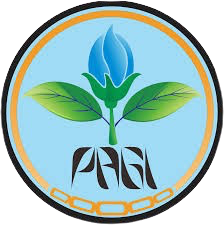Effect of Young Coconut Water Concentration on Bud Chip Germination Phase on Several Parts of Sugar Cane (Saccharum officinarum L.) Stems
DOI:
https://doi.org/10.22219/jtcst.v5i2.29726Keywords:
Bud chip, germination, growth regulator concentration, immersionAbstract
The germination phase is a crucial stage in the successful cultivation of sugarcane. Seeds obtained from six to eight-month-old gardens, extracted from sugarcane stems' protrusions, are used. These seeds have dormant bud characteristics, making them suitable for germination. Typically, a single sugarcane stem contains at least 13 buds, and farmers usually select seeds with 2-8 eyes per spike. However, excessive use of buds may result in abnormal seed growth, emphasizing the need for careful selection. The study utilizes the rase cage test system, dividing the sugarcane stem into upper, middle, and bottom sections to determine the optimal bud quantity in each treatment. It investigates the response of different parts of sugarcane bud chip stems to varying concentrations of coconut water growth regulator during germination. Employing a factorial randomized block design, the study includes two factors: Bud chip (BA: Upper Stem, BT: Middle Stem, BB: Bottom Stem) and coconut water growth regulator concentration (Z1: 25%, Z2: 50%, Z3: 75%, Z4: 100%). The positive control involves Agrogibb at a concentration of 120 ppm, with all treatments soaked for six hours. Conducted at the Indonesian Sugar Plantation Research Center on January 10, 2023, the study reveals that the BBZ1 treatment significantly affects the observed parameter of shoot emergence, with an average of 8.1 days. Conversely, the BAZ1 treatment shows the fastest and most efficient shoot emergence, with an average of 5.1 days, outperforming other treatments. These findings emphasize the significance of careful selection and treatment during the germination phase for optimal sugarcane productivity.
Downloads
References
Andayanie, W.R. 2013. Penggunaan Nomor Mata Tunas Dan Jenis Herbisida Pada Pertumbuhan Awal Tanaman Tebu (Sacharum officinarum L.). Agri-Tek. 14 (2): 67.
Arinta, R, P., Diana, A., Sri, W. 2017. The Effect of Growth Promoter to the Germination and Shoot Growth on PSJK 922 Sugarcane Variety. Proceeding Int. Sugar Conference. 45-56.
Asmarahman, Ceng. 2022. Perbanyakan Legume Cover Crop Desmodium trifolium Pada Beberapa Media Tanam. Journal Of Forestry Research. 5(1): 39–50.
Atmosoeprapto, K. 1971. Kebun Pembibitan. Syarat-Syarat yang Diperlukan Dalam Pemeliharaan dan Penyelenggaraannya. Buletin BP3G. 15:7.
Budianto E.A, Kaswan B, Ahmad A. 2013. Pengaruh Kombinasi Macam ZPT Dengan Lama Perendaman yang Berbeda Terhadap Keberhasilan Pembibitan Sirih Merah (Piper crocatum ruiz & pav) Secara Stek. Agrovigor. 6(2): 103-111.
Calvian, T.C.P. 2022. Pengaruh Zat Pengatur Tumbuh Terhadap Pertumbuhan Bibit Bud Set Tebu (Saccharum officinarum L.) varietas VMC 76-16. Skripsi. Program Studi Produksi Tanaman Perkebunan Jurusan Produksi Pertanian Politeknik Negeri Jember. Jember.
Darlina, Hasanuddin, Hafnati Rahmatan. 2016. Pengaruh Penyiraman Air Kelapa (Cocos nucifera L.) Terhadap Pertumbuhan Vegetatif Lada (Piper nigrum L.). Jurnal Ilmiah Mahasiswa Pendidikan Biologi. 1(1): 20-28.
Durroh, B., Y. Brilil Winarti. 2020. Pemanfaatan Air Kelapa Dan Aplikasi Pupuk Organik Untuk Merangsang Pertumbuhan Bibit Tebu G3 Hasil Kultur Jaringan. Agro Bali: Agricultural Journal. 3(1): 21-27.
Efendi H., Laoh B. 1981. Nomor Mata Tebu Sebagai Petunjuk Untuk Memilih Bibit yang Baik. BP3G. 230-236.
Ekaputri, D.H., Endah R.P., Purwono., Sri S. 2020. Studi Pematahan Dormansi dan Percepatan Pertunasan Ruas Batang Atas dan Bawah Tebu Untuk Meningkatkan Faktor Penangkaran. Jurnal Littri. 27 (1): 1-11.
Fandi, M.N.A. 2019. Pengaruh Lama Perendaman ZPT Giberelin (Ga3) Terhadap Pertumbuhan Bibit Tebu (Saccharum officinarum L.) Varietas PS 862. Skripsi. Program Studi Produksi Tanaman Perkebunan. Jurusan Produksi Pertanian Politeknik Negeri Jember. Jember.
Firmansyah, D. B., M. D. Anwar, N. Fitriyah. 2021. Efektivitas Konsentrasi Dan Lama Perendaman Air Kelapa Hijau Terhadap Pertumbuhan Awal Mata Tunas Bud Chips Tebu (Saccharum Officinarum L.) Varietas Ps 881. Jurnal Ilmiah Hijau Cendikia. 5(2): 2021.
Fitri, K., Tini, S., Dikdik, H. 2017. Aplikasi Berbagai Bahan ZPT Alami Untuk Meningkatkan Pertumbuhan Bibit Kemiri Sunan (Reutealis trisperma (Blanco) Airy Shaw). Jurnal Agro. 4 (1): 40-47.
Iskandar D. 2005. Pengkajian Penerapan Teknis Buku Budidaya Bibit Tebu Varietas PS 851 dan PS 951 Pada Tingkat Kebun Bibit Datar. Jurnal Agronomi. 9 (1): 17-21.
Khuluq, A, D., R., Hamida. 2014. Peningkatan Produktivitas Dan Rendemen Tebu Melalui Rekayasa Fisiologis Pertunasan. Jurnal Balitas. 13 (1): 13-24.
Maruapey A., Sangadji Z. 2022. Aplikasi Berbagai ZPT Alami untuk Meningkatkan Pertumbuhan Stek Batang Tebu (Saccaharum officinarum L). Journal of Agrotechnonogy and Science. 6(2): 92-105.
Mishra, R.G., Hartatik, S., Munandar, E. D., Winarsih, S. 2013. Studi Karakteristik Agronomi Beberapa Varietas Tebu (Saccharum officinarum L.) Hasil Kultur Jaringan Pada Berbagai Jarak Tanam. Agritrop Jurnal Ilmu-ilmu Pertanian. 5(1): 63-72.
Muhtarudin. 2012. Respon Perkecambahan dan Pertumbuhan Bibit Beberapa Jenis Kakao (Theobroma cacao L.) Dengan Pemberian Variasi Konsentrasi Giberellin (GA3). Skripsi. Universitas Pekalongan.
Nana, S. A., Salamah, Z. 2014. Pertumbuhan Tanaman Bawang Merah (Allium cepa L.) dengan Penyiraman Air Kelapa (Cocos nucifera L.) Sebagai Sumber Belajar Biologi SMA Kelas XII. JUPEMASI-PBIO. 1(1): 82 – 86.
Nasamsir., Deffi H. 2020. Pertumbuhan Bibit Bud Chip tebu (Sacharum officinarum L.) Pada Beberapa Dosis Pupuk Kandang Kotoran Sapi. Jurnal Media Pertanian. 5 (2): 27-33.
Pawirosemadi, M. 2011. Dasar-Dasar Teknologi Budidaya Tebu dan Pengolahan Hasilnya. Cetakan Pertama. UM Press. Malang.
PTPN XI. 2010. Panduan Teknik Budidaya Tanaman Tebu (PT. Perkebunan Nusantara XI Persero).
Pujiati, Gunawan B., Purwanti. 2014. Kajian Macam Varietas dan Konsentrasi ZPT Organic Terhadap Perkecambahan Stek Tanaman Tebu (Saccharum officinarum L.). Jurnal Fakultas Pertanian Universitas Garut. XIV: 11-22.
Purwati, R.D., Parnidi. 2016. Pengadaan Benih Tebu Bermutu. Peningkatan Produktivitas Tebu Untuk Mempercepat Swasembada Gula. IAARD Press. Jakarta.
Rachmawati, D. L., Roviq, M., Islami, T. 2017. Komposisi Atonik dan Air Kelapa Pada Pertumbuhan Bud Chips Tebu (Saccharum officinarum L.). Jurnal Produksi Tanaman. 5 (5): 851–859.
Riny, R.T. 2014. Pengaruh Penggunaan Air Kelapa terhadap Pertumbuhan Tanaman Sawi. Biopendix. 1(1): 83-91.
Selvia N,I., Meiriani., Yaya H. 2015. Keragaan Bibit Bud Chip Tebu (Saccharum officinarum L.) dengan Perlakuan Lama Perendaman dan Konsentrasi IAA. Jurnal Online Agroekoteknologi. 3(2): 489-498.
Situmeang, H. P., A. Barus., Irsal, 2015. Pengaruh Konsentrasi Zat Pengatur Tumbuh dan Sumber Bud Chips Terhadap Pertumbuhan Bibit Tebu (Saccharum officinarum) di Pottray. Jurnal Online Agroekoteknologi. 3(3): 992-1004.
Supriyanto., Kaka. E. P. 2011. Pengaruh Zat Pengatur Tumbuh Rootone-F Terhadap Pertumbuhan Stek Duabanga Mollucana Blume. Jurnal Silvikultur Tropika. 3 (1): 59-65.
Tahir, M., I. H. Khalil., H. Rahman. 2014. Evaluation of Important Characters for Improving Cane Yield in Sugarcane (Saccharum sp.). Sarhad Journal of Agriculture. 30 (3): 319-323.
Wareing, P.F., I.D.J. Phillips. 1981. The Control of Growth and Differentiation in Plants. Pergamon Press. New York.
Yong, J.W, Ge, L., Ng, YF., Tan, S.N. 2009. The Chemical Composition and Biological Properties of Coconut (Cocos nucifera L.) Water. Molecules. 14. 5144-5164.
Zaini, A.H., M. Baskara., K.P. Wicaksono. 2017. Uji Pertumbuhan Berbagai Jumlah Mata Tunas Tebu (Saccharum officinarum L.) Varietas VMC 76-16 dan PSJT 941. Jurnal Produksi Tanaman. 5 (2): 182-190.
Downloads
Published
How to Cite
Issue
Section
License
Copyright (c) 2023 Alfarizi Arinta Rury Puspitasari, Machmudi, Erfan Dani Septia, Rifqi Ahmad Alfarizi

This work is licensed under a Creative Commons Attribution-ShareAlike 4.0 International License.
Authors who publish with this journal agree to the following terms:
- Authors retain copyright and grant the journal right of first publication with the work simultaneously licensed under a Creative Commons Attribution License that allows others to share the work with an acknowledgement of the work's authorship and initial publication in this journal.
- Authors are able to enter into separate, additional contractual arrangements for the non-exclusive distribution of the journal's published version of the work (e.g., post it to an institutional repository or publish it in a book), with an acknowledgement of its initial publication in this journal.
- Authors are permitted and encouraged to post their work online (e.g., in institutional repositories or on their website) prior to and during the submission process, as it can lead to productive exchanges, as well as earlier and greater citation of published work (See The Effect of Open Access).











